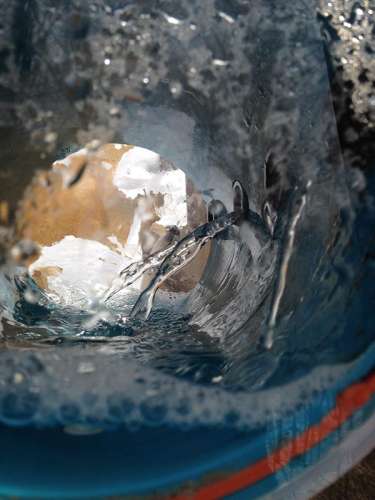I think we left off right about the time the weather broke and the sap started flowing. Well, flow it did. In nine days, we septupled the amount of syrup we made in the previous month. After that, we sold about 10,000 gallons of sap, which gave us our “crop.” I’ve been doing this for a long time, and I’ve seen plenty of years where we’ve had two-week seasons. Most all those years were bad, though. I can’t remember a year when we made a whole crop in 13 days.
Ironically, I think the cold weather in March improved our April productivity. The whole trick with a vacuum system is that the lines have to be airtight, which can be difficult for us to achieve because we’re understaffed. Once the sap starts running, we’ve got to be trucking and processing it; there’s just no time to walk lines in the woods. This year, though, the delayed season gave us the time to really walk every inch of our tubing system and fix every little leak before the season started. Once it finally started to run, this work paid off.
We also benefitted from the sugarmakers up the road who buys our sap. It’s a family operation; the son coordinates sap collection (they tap and collect from their own trees, as well as buying sap from other local producers); the father just makes syrup – it comes off a beautiful shiny new 5 x 14 in an almost steady stream; and the uncle sells the syrup. In the evenings trucks are lined up three or four in a row waiting to sell sap. I waited in line one night behind a man and his proud, probably ten-year-old son, who’d brought in maybe 100 gallons that they’d collected from buckets. Behind me in line was a guy from a major operation hauling 1,300 gallons at a clip. The whole thing felt old school in a good way. This idea of community sugaring, where people from all over bring sap in to a central processing facility, is heartening in that it allows people to get into the game without having to make a major investment in a sugarhouse or, conversely, into a sugarbush. It’s a good illustration of how capitalism engenders creativity. As sugarmakers, we could bemoan the increased competition now that so many people are getting into sugaring. Or we could look at it and see that the extra sap on the market has helped this operation’s economy of scale, and now there’s a new market for our sap that didn’t exist five years ago. Instead of killing ourselves trying to get the sap boiled before it spoils, now we can sell it.
Anyway, that’s the report from Vermont. Let me know how you other sugarmakers made out. And thanks, as always, for reading.
Dispatch from the Sugarwoods 2014 - Part 3



Discussion *